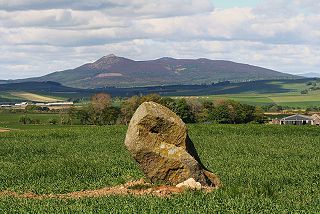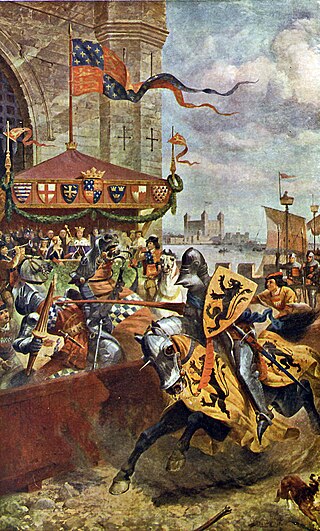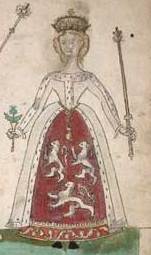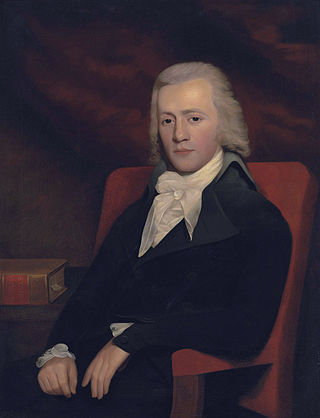
The Battle of Harlaw was a Scottish clan battle fought on 24 July 1411 just north of Inverurie in Aberdeenshire. It was one of a series of battles fought during the Middle Ages between the barons of northeast Scotland against those from the west coast.
The Earl or Mormaer of Ross was the ruler of the province of Ross in northern Scotland.
George Gordon, 4th Earl of Huntly was a Scottish nobleman.

James Hamilton, 1st Lord Hamilton, 6th Laird of Cadzow was a Scottish nobleman, scholar and politician.

David Lindsay, 1st Earl of Crawford was a Scottish peer who was created Earl of Crawford in 1398.
Hugh [probably Gaelic: Aodh], was the third successor of Ferchar mac in tSagairt as Mormaer of Ross (1323–1333).
Euphemia I, also called Euphemia of Ross and Euphemia Ross, and sometimes incorrectly styled Euphemia Leslie and Euphemia Stewart, was a Countess of Ross in her own right.

Euphemia de Ross (1329–1386), a member of Clan Ross, was Queen of Scots as the second wife of Robert II of Scotland.

Sir Walter Leslie was a 14th-century Scottish nobleman and crusader, one of the foremost knights of his time.
Euphemia Elphinstone was a mistress of James V of Scotland and the mother of his son Robert Stewart, 1st Earl of Orkney, born in 1532, as well as another child who died in childhood. One of her sons with her husband John Bruce was Laurence Bruce of Cultmalindie (1547–1617), the builder of Muness Castle.
Alexander Leslie, Earl of Ross was a Scottish nobleman. Born between 1367 and 1382, he was the son of Walter Leslie, Lord of Ross and Euphemia I, Countess of Ross. In around 1394, or not later than 1398, he became Earl of Ross and sometime before 1398 he married Isabel Stewart, daughter of Robert Stewart, Earl of Fife who became Robert Stewart, Duke of Albany. They had one child, Euphemia. He died at Dingwall, Scotland on 8 May 1402.
Mariota, Countess of Ross was the daughter of Euphemia I, Countess of Ross and her husband, the crusading war-hero Walter Leslie, Lord of Ross. Upon the death of her brother, Alexander Leslie, Earl of Ross, she became the heir-presumptive of her niece Euphemia II, Countess of Ross although her husband Domhnall of Islay, Lord of the Isles pressed Mariota's superior claim to the earldom.
Mairead inghean Eachainn, also known as Mairead nic Eachainn, was a consort of Alexander Stewart, Earl of Buchan. She was the daughter of a man named Eachann, and probably the mother of several children, including Alexander's like-named son, Alexander Stewart, Earl of Mar.

David Stewart, Prince of Scotland, was a 14th-century Scottish magnate. He was the eldest son of the second marriage of King Robert II with Euphemia de Ross. King Robert, on 26 March 1371, the day of his coronation, created him Earl of Strathearn, and on the following day his son David performed homage to his father as of Earl of Strathearn.
Euphemia Stewart, Countess of Strathearn was a medieval Scottish noblewoman, the daughter of David Stewart, Earl Palatine of Strathearn and Caithness. She succeeded to both her father's titles after his death between 1385 and 1389, probably March 1386.
Margaret Douglas, Countess of Douglas, known as the Fair Maid of Galloway, was a Scottish noblewoman, and a member of the Black Douglas family towards the end of the family's position as a major power in Scotland.

William Erskine, Lord Kinneder (1768–1822), was a friend and confidant of Sir Walter Scott, and a scholar and songwriter.
Agnes Syme Macdonald was a Scottish suffragette who served as the secretary of the Edinburgh branch of the Women's Social and Political Union (WSPU) before setting up the Edinburgh Women Citizens Association (WCA) in 1918. She was WCA's first and longest-serving secretary. She campaigned on various social issues and was active in the Quaker relief work for European refugees ; the Barns School for delinquent city boys and the Edinburgh Old People's Welfare Council.
Elizabeth Barlay or Barlow was an English lady in waiting to Margaret Tudor the wife of James IV of Scotland.
Euphemia Gilchrist Gibb became Euphemia Gilchrist Somerville was a Scottish social worker and local politician.






